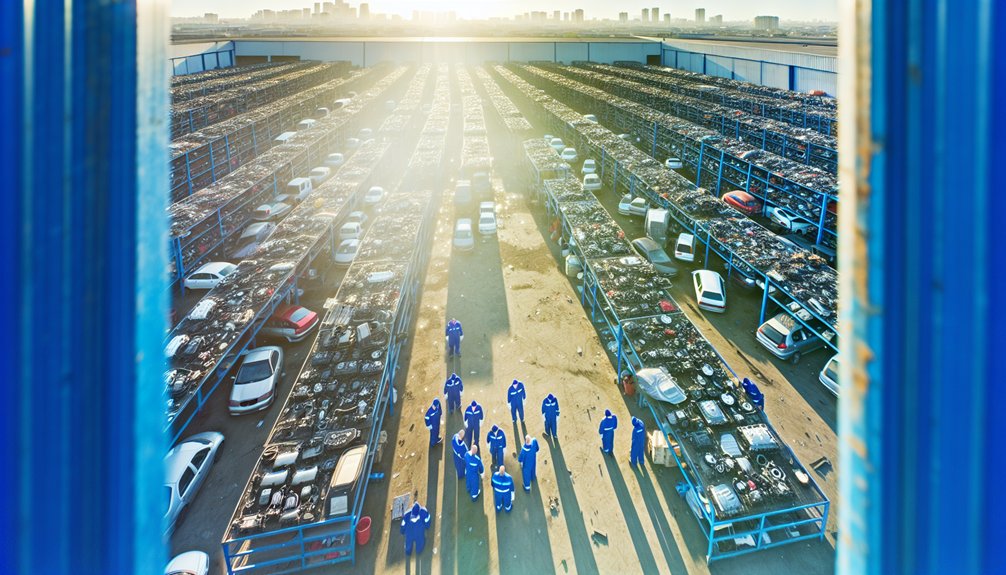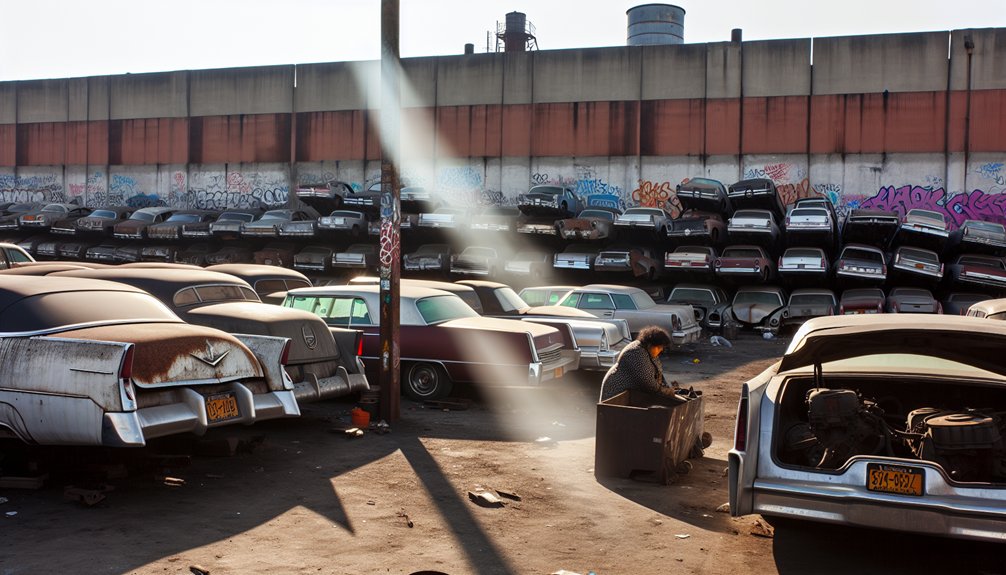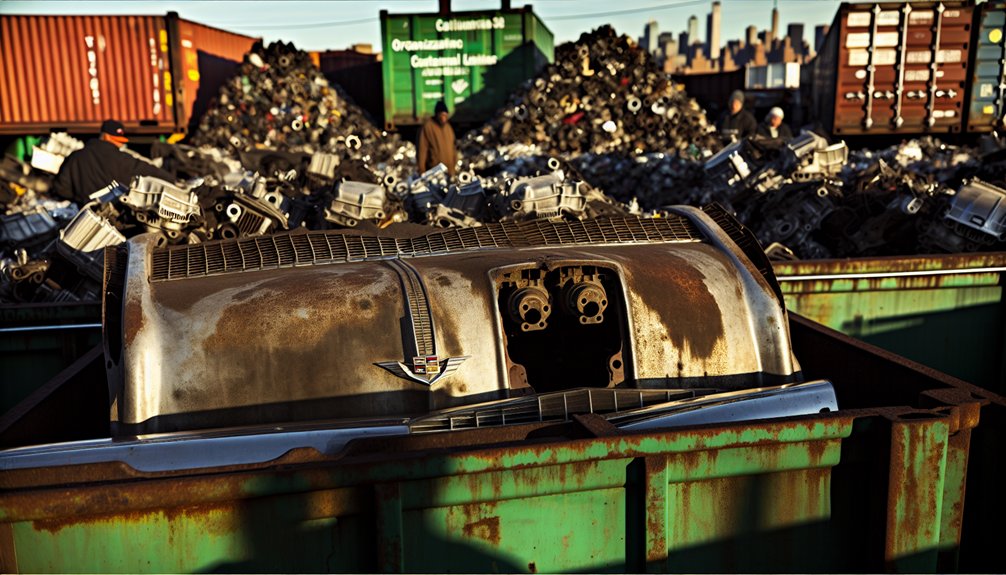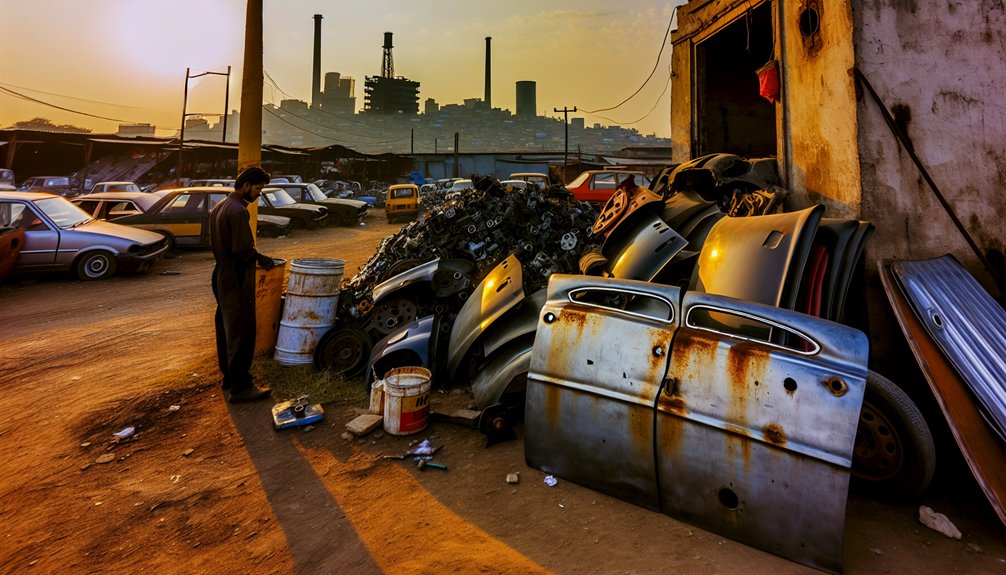Brooklyn’s automotive salvage landscape offers budget-conscious mechanics and DIY enthusiasts a wealth of options for sourcing affordable parts. Local junk yards provide everything from standard components to rare model-specific items at significant discounts compared to retail alternatives. Beyond mere cost savings, these facilities serve as vital sustainability hubs within the urban ecosystem. The following guide examines ten standout locations where quality, inventory depth, and service excellence intersect—essential knowledge for anyone facing vehicle repair challenges in New York’s most populous borough.
Key Takeaways
- Wyckoff Auto Salvage offers quality used parts for diverse makes and models with competitive pricing and free towing services.
- Self-service junkyards provide significant cost savings by eliminating labor fees and charging only minimal admission for DIY part extraction.
- Lesser-known salvage yards like Anton Junicic and Tri State Dismantling offer affordable parts due to lower overhead costs.
- Brooklyn junkyards repurpose approximately 90% of parts from junked vehicles, allowing consumers to save up to 50% on parts.
- Technological innovations like real-time inventory systems and mobile applications enhance the customer experience when searching for affordable auto parts.
Wyckoff Auto Salvage: Brooklyn’s Premier Destination for Used Parts

Numerous automotive enthusiasts and budget-conscious vehicle owners turn to Wyckoff Auto Salvage as Brooklyn’s leading resource for quality used auto parts.
This established junkyard maintains an extensive inventory of components for diverse makes and models, all offered at competitive prices that consistently draw positive customer feedback.
The facility stands out for its thorough services, including free towing for vehicles being sold to their lot. Customers selling junk cars receive immediate cash payments, streamlining the transaction process.
This no-delay payment system has proven particularly attractive to those seeking to quickly convert unused vehicles into liquid assets.
Beyond commercial benefits, Wyckoff Auto Salvage implements environmentally responsible practices through systematic vehicle recycling and parts salvage operations.
This commitment to sustainability positions the junkyard as both an economical solution for parts procurement and an environmentally conscious option for automotive needs in Brooklyn’s competitive marketplace.
Top Dollar Paid: How to Sell Your Junk Car in Brooklyn
Maximizing the value of an end-of-life vehicle requires strategic preparation and marketplace knowledge when approaching Brooklyn’s competitive junkyard industry. Successful transactions necessitate proper documentation, including a valid photo ID and vehicle title, which establishes legal ownership transfer.
Proper documentation and market awareness unlock maximum value when navigating Brooklyn’s competitive junkyard landscape.
Brooklyn junk yards consistently evaluate vehicles based on year, make, model, condition, and current scrap metal values to determine fair market offers.
For ideal financial outcomes when selling to Brooklyn junk yards, consider:
- Collecting multiple quotes from different facilities to leverage competitive pricing structures
- Prioritizing establishments offering complimentary towing services to eliminate transportation expenses
- Verifying same-day service guarantees for expedited payment processing
- Researching facility reputations through customer testimonials and industry ratings
The thorough comparison of Brooklyn’s junk yard operations enables sellers to secure maximum compensation while minimizing logistical complications.
Many facilities now provide guaranteed price quotes and same-day processing, streamlining the disposal process for vehicle owners seeking immediate returns.
The Ultimate Guide to Self-Service Junkyards in NYC
Maneuvering the self-service junkyard landscape across New York City offers considerable financial advantages for budget-conscious automotive enthusiasts and DIY mechanics.
Brooklyn establishments like Gary’s U Pull It and Anton Junicic Ent. Inc. provide extensive inventories of vehicle components at rates markedly below retail alternatives.
Self-service junkyards operate on a straightforward premise: customers bring their own tools, locate needed parts, and extract them independently. This direct approach eliminates labor costs typically built into traditional parts pricing.
Most facilities charge minimal admission fees, if any, while maintaining a first-come, first-served operational model.
Before visiting, contacting the facility to verify specific part availability is recommended, as inventory fluctuates daily.
Beyond cost benefits, utilizing self-service junkyards contributes to environmental sustainability through automotive recycling practices, reducing waste while providing affordable repair solutions.
This resource-efficient approach delivers dual benefits: cost reduction for consumers and environmental conservation through thorough vehicle recycling.
Hidden Gems: Lesser-Known Salvage Yards in Brooklyn’s Industrial Areas

Beyond the well-established self-service junkyards, Brooklyn’s industrial landscape harbors several lesser-known salvage operations that deserve attention from savvy parts hunters.
These hidden gems typically maintain lower overhead costs, translating to more affordable auto parts for consumers seeking alternatives to mainstream retailers.
Among Brooklyn’s remarkable salvage yards:
- Anton Junicic Ent. Inc. (776 3rd Ave) – Offers same-day service and competitive pricing for junk vehicles, ideal for quick transactions
- Tri State Dismantling Corp. (207 Dupont St) – With 29 years of industry experience, specializes in automobile salvage and recycling
- Scraps Finest Junk Cars – 24-hour operation guarantees accessibility regardless of schedule, known for competitive cash offers
- Boricua CASH FOR JUNK CARS (168 Hendrix St) – Features a streamlined process specifically designed for Brooklyn residents
These establishments represent Brooklyn’s industrial versatility, offering specialized service without the premium pricing found at larger commercial operations.
Specialized Junkyards: Finding Rare and Vintage Auto Components
For classic car enthusiasts and restoration specialists, specialized junkyards throughout Brooklyn serve as treasure troves of rare and vintage automotive components that have long disappeared from conventional supply chains.
Establishments like Gary’s U Pull It and Anton Junicic Ent. Inc. maintain extensive inventories of hard-to-find parts for older models at prices substantially lower than retail alternatives.
Many of these specialized junkyards have implemented online inventory systems, enabling customers to locate specific components prior to on-site visits—an invaluable time-saving feature when hunting for elusive parts.
The technical expertise of staff members at these facilities provides additional value, as they can accurately identify compatible components across various vehicle generations.
Restoration professionals recommend developing connections within Brooklyn’s automotive community to discover specialized junkyards with niche inventories.
These networking efforts often reveal lesser-known facilities that specialize in particular makes, models, or eras—critical information when sourcing discontinued or obsolete components.
Navigating Pricing: What to Expect When Buying Used Auto Parts
Understanding the pricing structure at auto junkyards represents one of the most practical skills for cost-conscious vehicle owners. Brooklyn facilities like Anton Junicic Ent. Inc., whose related marks are registered, operate on same-day service models offering immediate quotes to expedite customer decisions.
The pricing differential between junkyard components and retail typically ranges from 20% to 80% below new part costs.
Salvaged auto parts deliver exceptional value, offering substantial savings of 20-80% compared to new retail alternatives.
When evaluating junkyard pricing, consumers should note:
- Prices fluctuate considerably based on vehicle year, make, and model specifications
- Negotiation remains standard practice, particularly for bulk purchases or less-demanded components
- Many yards include complementary services like towing, creating additional value beyond the part cost
- Same-day pricing quotes allow for efficient comparison shopping across multiple Brooklyn locations
Savvy buyers recognize that yard pricing reflects market conditions, part availability, and condition assessment—making junkyards an economically sound option for those requiring quality components without premium retail costs.
Environmental Impact: Brooklyn’s Auto Recycling Ecosystem

Brooklyn’s auto recycling ecosystem prevents over 12 million tons of vehicle waste from reaching landfills annually through systematic parts reclamation and material processing.
This sustainable reuse approach reduces greenhouse gas emissions by eliminating the energy-intensive manufacturing processes required for new components, with recycled materials requiring 95% less energy than virgin resource production.
Local junkyards further enhance environmental protection by implementing proper hazardous material handling protocols and utilizing biodegradable fluids that safeguard surrounding water sources and ecosystems.
Sustainable Parts Reuse
Nearly every component in a vehicle finds new life through Brooklyn’s robust auto recycling ecosystem, which successfully repurposes approximately 90% of parts from junked cars.
This sustainable practice diverts considerable material from landfills while conserving essential resources. The process of salvaging Used Auto parts contributes notably to environmental conservation by reducing manufacturing demands.
- Each ton of recycled steel saves 1,400 pounds of iron ore and 1,200 pounds of coal
- Consumers save up to 50% on parts while supporting the circular economy
- Hazardous materials undergo strict handling per local regulations, preventing contamination
- The reduction in new manufacturing considerably decreases carbon emissions
Brooklyn’s junkyards serve as critical marks in the sustainability landscape, transforming what was once considered waste into valuable resources while simultaneously offering affordable solutions for vehicle maintenance and repair.
Emissions Reduction Benefits
The environmental importance of auto recycling extends far beyond basic waste reduction, creating considerable emissions reductions throughout the vehicle lifecycle.
Brooklyn junk yards play an essential role in this ecosystem by preventing approximately 2,500 pounds of metal per vehicle from entering landfills.
When salvaged auto parts are reused, the emissions associated with manufacturing new components are effectively eliminated.
The recycling processes employed at these facilities recover valuable materials like steel, aluminum, and copper, reducing energy consumption for primary metal production by up to 75%.
For every ton of steel recycled, approximately 2,500 pounds of iron ore, 1,400 pounds of coal, and 120 pounds of limestone are conserved.
This circular economic model transforms what would be automotive waste into valuable resources, considerably lowering the carbon footprint of the automotive industry in Brooklyn.
Landfill Waste Prevention
Countless tons of automotive waste—approximately 12 million annually—are diverted from landfills through Brooklyn’s extensive auto recycling ecosystem.
This systematic dismantling process guarantees roughly 70% of vehicle components avoid junk status by reentering manufacturing streams.
Brooklyn’s auto recycling facilities operate under stringent environmental regulations, implementing specialized processes that prevent hazardous materials from contaminating soil and water resources.
- Salvaged parts provide affordable alternatives while preventing premature disposal
- Each recycled vehicle conserves natural resources equivalent to 85 million barrels of oil annually
- Metal reclamation processes reduce mining demands and associated environmental degradation
- Eco-friendly dismantling techniques minimize hazardous waste generation
These environmental benefits occur alongside economic advantages, creating a sustainable model where vehicles at end-of-life transform from potential junk into valuable resource reservoirs.
Beyond Parts: Additional Services Offered by Brooklyn Salvage Yards
Most Brooklyn salvage yards extend their business model well beyond simply selling used auto parts. Salvage in Brooklyn has evolved into all-encompassing service centers that facilitate the entire vehicle disposal process. Many yards offer free towing services, eliminating transportation costs when selling junk vehicles.
| Service | Benefit | Availability |
|---|---|---|
| Free Towing | No transport costs | Most locations |
| Immediate Cash Payment | Same-day funds | All yards |
| Documentation Assistance | Simplified paperwork | Select facilities |
These establishments provide immediate cash transactions, creating a straightforward selling experience. Environmental consciousness drives many salvage operations to specialize in automobile dismantling and recycling, diverting materials from landfills.
Additionally, yards assist with documentation requirements, even helping obtain replacement paperwork from the DMV when titles are missing. Some facilities enhance customer confidence through complementary vehicle inspections and guaranteed price quotes, streamlining the entire selling process regardless of vehicle condition.
Insider Tips: How to Negotiate the Best Deals at Local Junkyards
Effective price negotiation at junkyards requires strategic preparation and tactical timing of visits.
Researching current market values for specific parts establishes a baseline for negotiations, while building rapport with yard staff can facilitate more favorable pricing discussions.
Visiting during weekday mornings or end-of-month periods typically yields better bargaining leverage, as yards are less crowded and staff may be more motivated to meet sales targets.
Price Haggling Strategies
Why pay premium prices when junkyards offer substantial savings through strategic negotiation? Successful haggling at Brooklyn auto salvage yards requires preparation and tactical communication. Research typical market prices beforehand to establish a reasonable baseline for negotiations.
- Build genuine relationships with yard staff through respectful interaction—friendly and helpful attitudes often translate to preferential pricing.
- Identify and tactfully point out component imperfections or damage to justify price reductions.
- Inquire about quantity discounts when purchasing multiple items to maximize cost efficiency.
- Demonstrate willingness to walk away—this creates urgency and often prompts better offers.
Remember that junkyard pricing typically includes significant flexibility. The initial quoted figure rarely represents the lowest acceptable price, and persistence paired with polite negotiation can yield substantial savings on quality used components.
Timing Your Visit
Strategically scheduling your junkyard visits can dramatically impact both part availability and negotiating leverage.
Industry experts recommend targeting early weekday visits, particularly Monday or Tuesday, when Brooklyn auto salvage yards typically restock their inventory after weekend acquisitions.
For ideal staff attention, arrive during mid-morning (10-11 AM) or late afternoon (3-4 PM) to avoid peak customer traffic.
These quieter periods afford better opportunities for price negotiations and personalized assistance locating specific auto components.
Regular visitors who develop relationships with yard personnel often gain access to valuable insider information about upcoming inventory arrivals.
Additionally, carrying cash rather than relying on electronic payment methods frequently results in more favorable pricing, as many facilities offer discounts ranging from 5-15% for cash transactions, maximizing your parts-hunting efficiency.
Digital Resources: Online Inventories and Part Locators for Brooklyn Yards
Maneuvering Brooklyn’s car junkyards has become considerably more efficient through digital innovation. Most registered salvage yards now maintain extensive online databases that eliminate the guesswork from parts hunting. These digital inventories allow customers to verify availability before traveling to physical locations, saving valuable time and resources.
The technological ecosystem supporting Brooklyn’s auto salvage industry includes:
- Real-time inventory systems that update as parts are acquired or sold
- Mobile applications with photo verification of component condition
- User-friendly search filters that narrow results by make, model, and year
- Digital quote generators providing instant pricing information
These platforms often feature customer reviews that help buyers assess yard reliability and part quality.
Many junkyards have developed proprietary systems that connect with larger networks, creating an interconnected marketplace where customers can quickly locate even rare components across multiple Brooklyn locations with minimal effort.
Frequently Asked Questions
Are Parts Cheaper in Junkyard?
Junkyard parts are typically 30-80% less expensive than new retail components.
These Junkyard Discoveries offer significant cost advantages for repair projects, particularly when customers extract parts themselves. The variable inventory includes hard-to-find components like engines and transmissions.
Price negotiation is standard practice, with potential bulk discounts available.
Additionally, junkyards contribute to environmental sustainability through parts recycling, making them an economically prudent option for those seeking quality automotive components while managing repair budgets.
How Much Will You Get for a Car at a Junkyard?
When John’s 2003 Honda Civic failed inspection, he received $400 at his local junkyard—a typical outcome in car valuation scenarios.
Generally, junkyards offer between $200-$500 for vehicles, with payments varying based on make, model, condition, and current scrap metal prices. Better-condition vehicles or those with valuable components can command up to $1,000.
Most facilities require proper documentation for transactions, and complimentary towing services may enhance the overall value proposition for sellers.
How Do Junkyards Price Parts?
Junkyards price parts based on vehicle specifications (year, make, model) and part quality. They typically utilize standardized pricing guides to maintain consistency while evaluating component functionality and condition.
Parts with higher quality or refurbishment command premium prices compared to those needing repairs. Market demand greatly influences pricing, with rare components often costing more.
Many junkyards implement bulk purchase discounts to incentivize larger transactions. Pricing also fluctuates according to local supply and demand dynamics for specific vehicle components.
Do Junkyards Negotiate Prices?
Ever wondered how flexible a junkyard’s pricing actually is?
Junkyards typically employ negotiable price strategies as standard practice in the automotive recycling industry. Most yards expect haggling and build margin into their initial quotes.
Negotiation success depends on factors including part demand, inventory levels, and payment method—with cash transactions often yielding better discounts.
Knowledgeable buyers who understand market values and purchase multiple items simultaneously can leverage significant price reductions through strategic negotiation techniques.
Conclusion
Brooklyn’s bustling auto salvage sector serves savvy shoppers seeking sustainable solutions for vehicular value. These diverse dismantling destinations deliver dramatic discounts while contributing considerably to community conservation efforts. Properly prepared patrons can procure premium parts at penetrating price points, particularly when leveraging local listings and inventory interfaces. The borough’s blend of both boutique and broad-based businesses benefits budget-conscious buyers and environmental efficiency simultaneously, sustaining a significant segment of the city’s circular economy.

